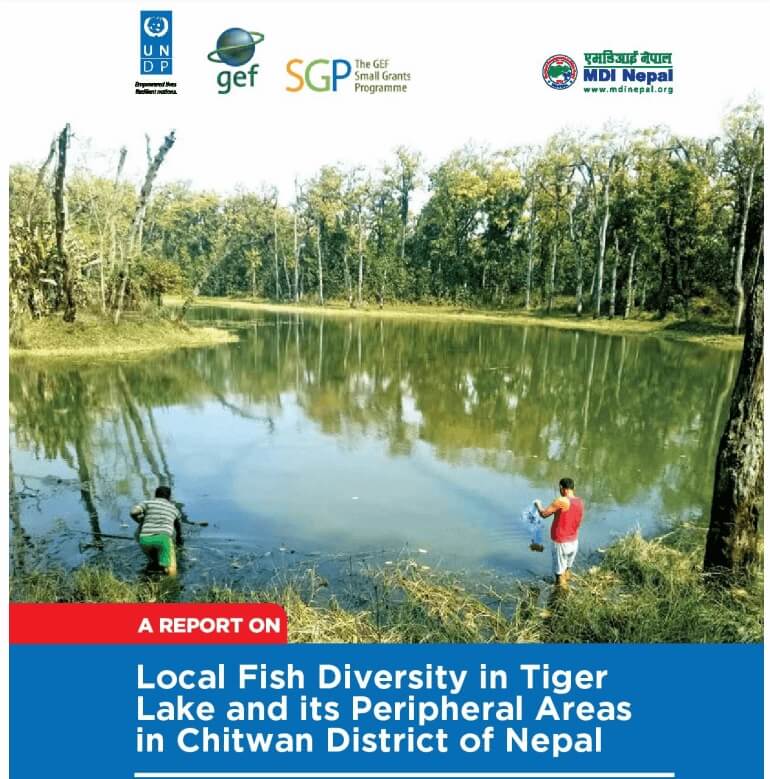Biodiversity

Study Reports on Local Fish diversity
Rare & Nutritious Fish Found in Chitwan
Promoting Local Fish Diversity in Selected Lakes of Chitwan through Eco-system-based Comanagement Practices
(Supported by UNDP GEF Small Grants Programme of Nepal, 2018-2020)
(Project No. NEP/SGP/OP6/Y3/STAR/BD/2018/05)
Summary
Local or native fishes are important in several respects. They are preferred locally, grow better under local conditions, contribute in biodiversity because of their self-recruiting nature, maintain integrity in aquatic communities and ecosystems and can be used in ornamental and sports fishing attracting angling-based ecotourism. They are rich in micronutrients and can adequately aid in food security, nutrition and medicinal purpose as well.
Freshwater native fishes are one of the most ignored fauna for conservation; as a result, alarming decline in fish diversity persists. Out of the total 252 native fish species recorded in Nepal, 236 are indigenous and only 16 are exotic. Out of the 236 native fish species, 34 species are found threatened at different level. The decline of native fish is associated with several factors. Uncontrolled fishing in the open water bodies is one of the main reasons causing decline of native fish species. Until recently, the local communities are widely using different kinds of traditional fishing gear like nets, baskets, rod and line, spearing, fish traps and indigenous fish poison, as well as some destructive fishing methods such as insecticides, pesticides, dynamiting and electric fishing and this has tremendously hampering the fish biodiversity in the river basins. This will continue even in the coming days unless a concentrated effort is made for conservation of aquatic resources especially the fish fauna which keeps major concern because of its economic efficiency that address people’s livelihood for almost 400 thousand populations in Nepal involved in capture fishery
For conservation of aquatic animals including fish, the government has promulgated ‘Aquatic Animal Protection Act (1960), Jalchar Samrachhan Ain 2061’. These acts prohibit indiscriminate killing of fish and aquatic animals by unconventional methods. However, to control the illegal fishing law enforcement has remained always been challenging. Thus, only the government efforts are not adequate. The adoption of community or cooperative based conservation could be one of the best approaches for restoring these native fish species.
For this purpose, Tiger lake in Bharatpur-11, Chitwan and its peripheral areas was chosen for implementation of the proposed project. The main purpose of this project was to conserve aquatic biodiversity, manage aquatic habitat, improve awareness among local communities particularly the CFUGs members on importance of small indigenous species (SIS) and improve co-management practices (ecosystem based) for restoring native fish species found in these lakes.
The project made required coordination with local Nava Jagriti Community Forestry User’s Group (CFUG) in Bharatpur-11 and Division Forest Office of Chitwan. The project conducted two studies; one for identification of local fish species from Tiger lake, Rhino lake, Khageri Khola and Rampur Ghole of Chitwan and another for identification terrestrial plants around Tiger lake and animals dependent with Tiger lake. The former study was carried out by the aquaculture experts from Agriculture and Forestry University (AFU), Rampur and second was carried out by Forest specialists from Division Forest Office, Chitwan. A total of 34 fish species have been identified from these four sectors (Tiger lake, Rhino lake, Khageri Khola and Rampur Ghole) of which highest Simpson’s Biodiversity Index (SBI) is seen in Rampur Ghole (0.08) followed by Tiger lake and Khageri Khola (0.12) and Rhino Lake (0.13) respectively. More importantly, some nutrient rich native fish species such as Mara (Amblypharyngodon mola) have been found in Rhino lake of Bharatpur Metrocity-12 for the first time in Chitwan which has very high in Vitamin A including those of Dedhuwa (Esomus danricus) having high iron level and Pothi (Puntius sophore) with high calcium level.
The project has established a Fish Museum and Biodiversity Information Centre (FMBIC) in Gaikharka of Bharatpur-11 in Bhojad where all 34 preserved species have been placed in jars for observation to general publics. The book related to these fish species have been published and displayed both in Nepali and English in the museum. The visitors in the museum can see the fish samples and take away the books freely for study purpose.
Thank You !

